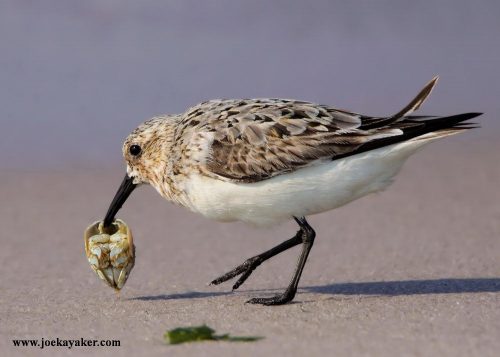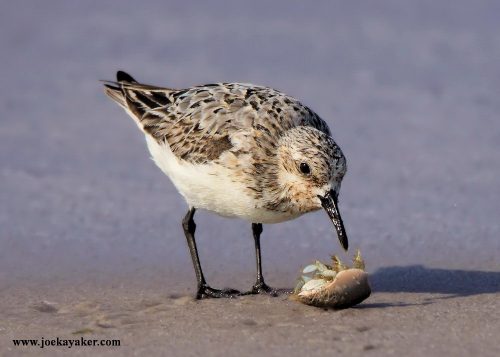Wednesday, August 14, 2019,
This is a Sanderling, a fairly common shorebird, and that is a Mole Crab having a bad day. Mole Crabs, also known as Sand Crabs are quite numerous here on the south shore. They are a favorite meal of other shorebirds, including Oystercatchers. Mole Crabs make their living by burrowing into the sand at the surf zone and filter plankton and other detritus from the water. As you can see, Sanderlings make at least part of their living by digging up and eating Mole Crabs. It’s a Sanderling eat Mole Crab world at the sea shore. JK
JK



How do mole crabs rate next to those beautiful fiddler crabs you also featured? What would the score be in the Sanderling vs. Fiddler Crab match up?
Um, this is a tough question that may not have a proper answer.
Fiddler crabs and Mole crabs live in different habitats. Fiddler Crabs live in muddy, tidal marshy areas, while the mighty and adventurous Mole Crabs prefer living in the surf zone of open beaches. Fiddler Crabs have the advantage of digging and living in fairly permanent holes whereas Mole Crabs are constantly on the move, making new burrows as they move back and forth with the moving tide.
Now to the Sanderling part of the equation. Most of the Sanderlings that I have observed tend to make their living at the surf zone. They are constantly running up and down the beach, heading out when the water recedes and rushing landward to avoid the oncoming waves. In between all this running, they are searching for goodies in the surf and under the sand. As I mentioned in this post, Oystercatchers also use this same method. However, I have seen Oystercatchers working slow moving waters and catching and eating yummy morsels such as Mussels. I have a premonition that Oystercatchers dining on Mole Crabs may be featured in a future Joe Kayaker post.
I don’t know if Sanderlings ever work slow water zones but I imagine they do.
So, I guess the short explanation is that Sanderlings are much more likely to find Mole Crabs on their usual turf (the surf), rather than Fiddler Crabs.
This does not mean that Fiddler Crabs live an easy life. There’s always some that wants to eat them. For instance, there are a couple of places I visit where those beautiful Fiddler Crabs seem to be a favorite of Yellow-crowned Night Herons. I’ve got pics of that action as well.
Look at all this writing. This is longer than my average blog post. I should take all this and make it a post. No one reads this Reply section anyways. I think you’re the only one. However, that was an excellent question. It had to be, to generate such a long answer from me. JK.
That was a very informative answer! You keep this up, they’ll be having you write articles for Nature section of magazines! 🙂 I was thinking that the Fiddler Crabs looked so much bigger than the Mole Crabs that I wondered if a Sanderling would be big enough to handle it — especially with that big fiddle claw. But I had neglected to consider habitat and thought the Fiddlers were at the same place you found the Mole guys. I’m guessing if a Yellow-crown could eat a Fiddler, so could a Sanderling and Oyster Catcher for that matter. And speaking of Oyster Catchers, I’m glad for the tip on the upcoming post! 🙂 I love those birds!